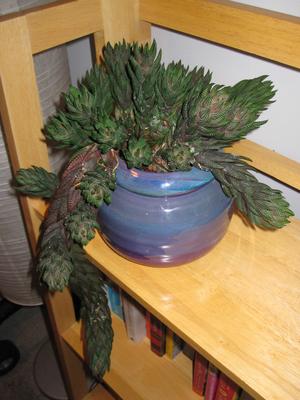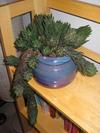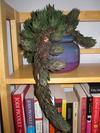




Hello! I received this lovely succulent (I think it’s a succulent) for a gift, and am having difficulty identifying it. It’s green, with just a few dark red areas. It looks as though it would be sharp to touch, but is not. Rather, it feels almost like you are petting a lizard or similar creature when touching it. I’m not quite sure how else to describe it, so I am including some pictures in hopes you might be able to help. Thanks so much!
This creature (!) is one of the many types of Haworthia. These little plants are great for beginning your collection if you’re just starting out, because they don’t require the extremely bright conditions of most succulents, and they also prefer a little more water. Over watering is the leading cause of death in succulents, so having one that doesn’t mind so much is the perfect solution.
If you look at the leaves, you’ll see that they have little transparent stripes – these are windows; no, I’m not kidding – the light passes through these windows to be processed with the sugars in the sap of the plant into energy. This process is known as photosynthesis – or making (synthesizing) energy out of light (photo). Just one more interesting tidbit of information on these great little plants.
You can see more about them here: Haworthia
Happy Succulent Gardening!
Jacki
Comments for Name That Plant!
| Sep 22, 2019 |
Hawthoria resendeana by: Michelle Hi, I believe this is a Hawthoria resendeana Haworthiopsis / Haworthia resendeana: Short, thick, densely packed leaves form a stacked rosette tower. The green leaves can turn reddish-brown in bright sun, but they also tolerate low-light conditions. This is a hybrid of unknown parentage, though it is thought to be related to H. coarctata. Haworthia are able to tolerate low, indoor light, making them excellent houseplants, even for beginners. They are particularly easy to grow and rarely affected by common succulent pests and diseases. Strong, drought-tolerant roots will grow if they have great drainage and infrequent water. Pick deep containers with drainage holes and a gritty, well-draining soil that is 50% to 70% mineral grit (coarse sand, pumice, or perlite). Water deeply enough for water to run out the drainage hole and allow the soil to completely dry before watering again. This genus tolerates high heat by slowing down and eventually going dormant in the peak of summer. This means that, unlike other succulents, it is important not to over-water or fertilize during summer dormancy and water a bit more frequently in the winter growing season. Haworthia are slow growers and tend to stay small in pots, but they will produce new offsets in clumps around their bases. These offsets can be left to develop into a dense clump or pulled off and transplanted. It typically prefers Low Indoor Light, Filtered / Partial Sun |

